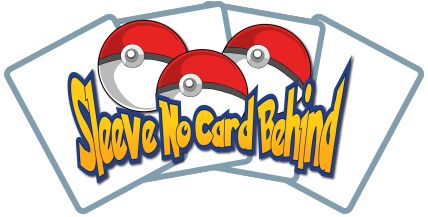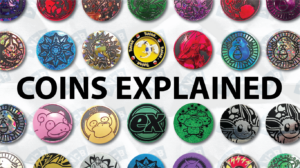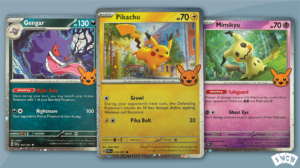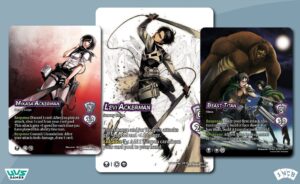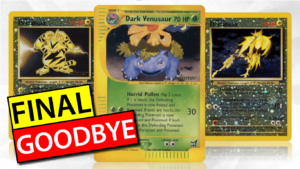5 Ways To Tell If Yu-Gi-Oh! Cards Are Fake
-
By: Oliver Copeland
- Published:
- Last Updated: February 7, 2024
There’s nothing worse than finding your childhood collection of YuGiOh cards, only to discover fake cards among the memories. But hey, it happens more often than you think. Some counterfeit cards can be deceiving though, so we put together a quick guide to tell if your cards are authentic or fake.
With these tips, you won’t have to try the rip test!
5. Spelling Mistakes
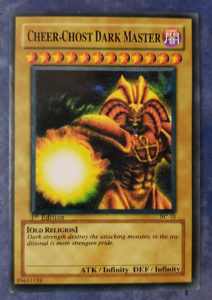
The first and most obvious sign that your card might be fake is poor spelling. This includes grammatical errors, spelling errors, and sometimes, very strange wording.
Official Yu-Gi-Oh! TCG cards sometimes have spelling errors, such as Chaos Emperor Dragon – Envoy of the End, but it is still very rare. When this does happen, the error is usually corrected for later prints.
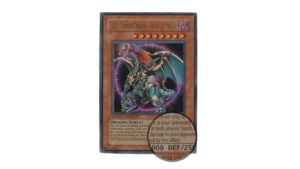
Look for multiple reoccurring spelling errors. Any card is capable of an innocent typo, but fake cards often have many. Check not only the spelling but the way a card reads as well. Does it sound odd or is it difficult to understand?
Sometimes fake cards will have random spaces. Look for words that are spread apart randomly or sometimes misaligned.
4. Eye of Wdjat and Copyright
Suppose you look at the bottom of an authentic Yu-Gi-Oh! card, then you will see two things that will help us authenticate.
The copyright text: “©1996 KAZUKI TAKAHASHI”
All older cards will have this copyrighted text. However, newer cards will instead have: “©2020 Studio Dice/SHUEISHA, TV TOKYO, KONAMI”.
The holographic sticker (The Eyes of Wdjat)
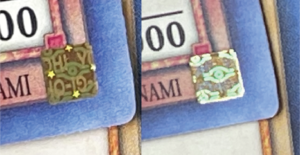
At the very bottom right of the card, you will also find a holographic sticker. Every authentic Yu-Gi-Oh! card will have this sticker, and it will be either silver or gold.
The sticker will show two different images as you move the card and view it from different angles. One image will be the Yu-Gi-Oh! text repeated, and the second will be an eye symbol, known as The Eye of Wdjat.
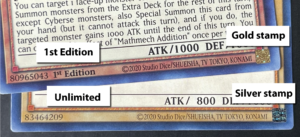
The Eyes of Wdjat sticker will be gold for 1st edition cards, and silver for unlimited (non-1st edition) cards.
3. Poor Quality
Yu-Gi-Oh! cards have a pretty high standard. Authentic cards are printed on good cardstock, and have bold colors and high-resolution images.
Fake cards will often be thin and flimsy, or even be printed on paper. Colors can sometimes be washed out or far from the original, and the images can be grainy or blurry.
2. Incorrect Card Names or Symbols
Type the name of your card into Google. A quick search can often bring suspicious cards to the surface. If the card you’re searching for is a poorly made bootleg, you’ll know right away because it will be hard to find online.
Some of the poorly made fake cards will have completely made-up names.
You’ll get a pretty good feel for card symbols, set names, and numbers if you organize your Yu-Gi-Oh! cards.
Check Google Images and you’ll see a bunch of images of the card you searched. Now compare yours to the images. Here are a few things to check:
- Is the font the same?
- Do the symbols match?
- How many symbols are there, and are they in the same place?
Your card should look almost identical to the results that pop up in your search. If you begin to notice too many differences, be suspicious.
There are many different symbols with various meanings in the Yu-Gi-Oh Trading Card Game, but all you need to look for is that your card matches everyone else’s.
1. Incorrect Colors
This can be a little tricky.
Just like your printer at home or at the office, the colors can vary. Luckily for us, colors don’t vary that much when they print Yu-Gi-Oh! cards.
You will notice, however, that different cards have different colors. For example, Normal Monster cards are brown, Trap cards are pink, and Spell cards are turquoise. There are others, but it’s the comparison that matters.
There is a natural difference between the North American and European prints of Yu-Gi-Oh! cards that you should be aware of too.
Again, we recommend searching your card on Google. Every screen is going to show colors a little differently, but you should be able to notice any mistakes, such as incorrect symbol colors.
You should also check the back of the card
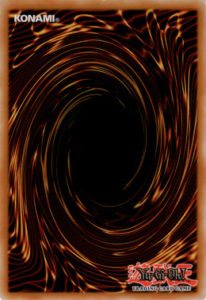
The reverse side of a Yu-Gi-Oh! card is much less detailed but still essential to authenticate.
This is what you need to look for:
- Correct colors
- Official Konami® logo (top left)
- The official Yu-Gi-Oh!™ TRADING CARD GAME logo (bottom right)
The back of a Yu-Gi-Oh! cards is not hard to fake, but sometimes the cheapest bootleg versions will be obvious.
There are some exceptions though…
For example, the three god cards The Winged Dragon of Ra, Obelisk the Tormentor, and Slifer the Sky Dragon, do not have the Konami or Yu-Gi-Oh! logo on the back. Furthermore, each back is tinted to match the card’s color, either yellow, blue, or red.
Accidents happen
All this being said, accidents happen and cards often make it past the printers and to retail with errors. It’s rare but you’ll sometimes find cards that have miscuts, poor centering, poor cuts, test misaligned, grammatical errors, misaligned text or symbols, etc.
And I should mention, cards with mistakes are often sought after, and sometimes can even be expensive!
But all of these errors are usually documented. For example, if you have a Dark Magician with the spelling error “Dark Magican” a quick Google search will confirm that this is not an official and documented error. At that point, it’s safe to consider the card a fake.
If you still need help
If you still have one or more cards that you can’t confidently authenticate, we recommend checking eBay.
eBay has a massive catalog of active and recently sold listings. Search your card on eBay and compare it to the listing images. Specifically, look for graded copies. If a card is graded, then it has been authenticated by professionals.
Look for similarities or differences between your copy and the authenticated one.
